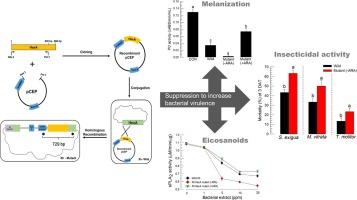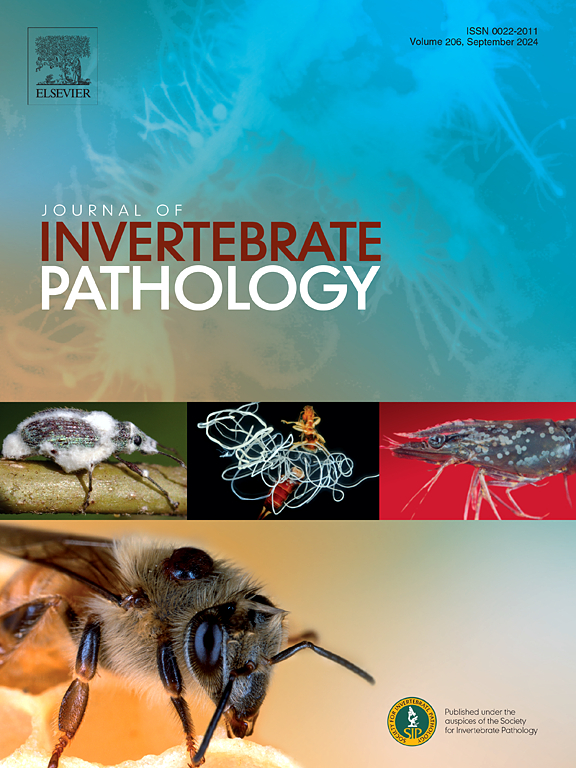抑制转录调节因子 HexA 是引发昆虫病原体 Xenorhabdus hominickii 的细菌毒力的关键。
IF 3.6
3区 生物学
Q1 ZOOLOGY
引用次数: 0
摘要
线虫共生细菌 Xenorhabdus hominickii 有两种不同的生活方式。当宿主线虫感染目标昆虫后,X. hominickii 被释放到昆虫血肠中,成为致病菌。本研究探讨了细菌生命形式中与转录调节因子 HexA 的活性有关的关键转变。当 X. hominickii 在胰蛋白酶大豆肉汤中培养时,HexA 在细菌生长的静止期表达。相反,当昆虫宿主 Spodoptera exigua 感染 X. hominickii 时,HexA 在其早期生长阶段表达。HexA 的瞬时表达被另一种转录调节因子 Lrp 的表达所取代,从而导致细菌毒性因子的产生。将 HexA 的启动子替换为由诱导剂 l-arabinose 控制的可诱导启动子后,HexA 的表达得到了控制。在没有诱导剂的情况下,突变细菌以较低水平表达 HexA,结果细菌培养液比野生型更能有效抑制昆虫的免疫反应。加入诱导剂后,HexA 的表达量很高,导致培养液无法有效抑制免疫反应。有趣的是,HexA 的表达抑制了另一种转录调节因子 Lrp 的表达,而 Lrp 反过来又诱导了一种非核糖体肽合成酶 gxpS 的表达,导致产生一种免疫抑制代谢物 GXP。抑制突变菌中 HexA 的表达会提高次级代谢产物中 GXP 的水平。这表明昆虫宿主感染 X. hominickii 后会抑制 HexA 的表达并上调 Lrp 的表达,从而产生 GXP。GXP 代谢物能抑制昆虫的免疫力,从而保护细菌-线虫复合体。因此,抑制昆虫血肠中 HexA 的表达对于细菌从共生生命形式转变为致病生命形式至关重要。本文章由计算机程序翻译,如有差异,请以英文原文为准。

Suppression of a transcriptional regulator, HexA, is essential for triggering the bacterial virulence of the entomopathogen, Xenorhabdus hominickii
A nematode-symbiotic bacterium, Xenorhabdus hominickii, exhibits two distinct lifestyles. Upon infection of its host nematode into a target insect, X. hominickii is released into the insect hemocoel and becomes pathogenic. This study examines the critical transformation in bacterial life forms concerning the activity of a transcriptional regulator, HexA. When X. hominickii was cultured in tryptic soy broth, HexA was expressed during the stationary phase of bacterial growth. Conversely, HexA was expressed in the early growth stage within the insect host, Spodoptera exigua, when infected with X. hominickii. The transient expression of HexA was succeeded by the expression of another transcriptional regulator, Lrp, which led to the production of bacterial virulent factors. Expression of HexA was manipulated by replacing its promoter with an inducible promoter controlled by the inducer, l-arabinose. In the absence of the inducer, the mutant bacteria expressed HexA at a low level, resulting in a bacterial culture broth that was more effective at suppressing insect immune responses than the wild type. When the inducer was added, HexA was expressed at high levels, rendering the culture broth ineffective in immunosuppression. Interestingly, expression of HexA inhibited the expression of another transcriptional regulator, Lrp, which in turn induced the expression of a non-ribosomal peptide synthetase, gxpS, leading to the production of an immunosuppressive metabolite, GXP. Suppression of HexA expression in mutant bacteria augmented GXP levels in secondary metabolites. This indicates that infection of X. hominickii into the insect host represses HexA expression and upregulates Lrp expression, leading to GXP production. The GXP metabolites inhibit insect immunity, thus protecting the bacteria-nematode complex. Therefore, the suppression of HexA expression in the insect hemocoel is crucial for the bacteria’s transition from a symbiotic to a pathogenic life form.
求助全文
通过发布文献求助,成功后即可免费获取论文全文。
去求助
来源期刊
CiteScore
6.10
自引率
5.90%
发文量
94
审稿时长
1 months
期刊介绍:
The Journal of Invertebrate Pathology presents original research articles and notes on the induction and pathogenesis of diseases of invertebrates, including the suppression of diseases in beneficial species, and the use of diseases in controlling undesirable species. In addition, the journal publishes the results of physiological, morphological, genetic, immunological and ecological studies as related to the etiologic agents of diseases of invertebrates.
The Journal of Invertebrate Pathology is the adopted journal of the Society for Invertebrate Pathology, and is available to SIP members at a special reduced price.

 求助内容:
求助内容: 应助结果提醒方式:
应助结果提醒方式:


